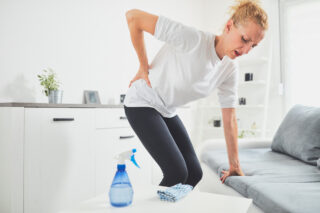
More Pain Management & Rehabilitation Articles
Housework Injuries: Low Back Pain and Knee Pain

Patients often visit their doctor due to housework accidents. As people stay home much longer than usual since this pandemic status, it has increased more than usual. People get injured with sprains and bruises by falling, overuse, repeated motions, and heavy lifting. There are some other cases including cuts, burns, and concussions.
The CDC reports that unintentional injuries are the leading cause of death for Americans under the age of 45. Also, it states that our homes are where we feel most comfortable, and they are also where many accidents happen.
The most common yard work injuries are low back pain and knee pain.
One of the most common complaints following a few hours of yard work is lower back pain. There are many yard activities that we do like weeding, mowing, digging, planting, and mulching. These can hurt our body if you are not careful, and it is easy to strain or pull the muscles in your back.
There are some cautions that we can consider for preventing lower back pain.
- Warming up: Take a few minutes to warm up your muscles by doing some exercises.
- Hydrating: Muscles need water to function and adequate water levels in your body can help prevent the onset of muscle cramps or spasms and help prevent dehydration.
- Mixing it up: Better keep changing and taking a turn on each work activities. Do not continuously perform any one activity for a long period.
- Proper posture: Leaning forward as you push the lawn mower can strain your back. Be sure to maintain proper posture and push with your arms and legs instead of your back.
- Weeding: Bending over at the waist for prolonged periods can cause your back muscles to start complaining. Better to try kneeling on a mat or siting directly on the ground instead if possible.
- Lifting carefully: When lifting bags of dirt or mulch. Please keep your back straight and bend with your knees and hips when reaching down if possible.
- Taking breaks: Taking your time will make it less likely for injuries to occur. Pushing yourself to the point of exhaustion can cause you to get injured.
The knee is the largest joint in the human body. Since the knee supports nearly the entire weight of the body, it is one of the most susceptible to injuries. Gardeners can cause knee bursitis. Prolonged or repetitive kneeling also can cause knee inflammation. If you do suffer with knee pain, particularly after gardening, it can help to ease discomfort if you put an ice pack on your knees. You need to remember RICE: Rest, Ice, Compression and Elevation. Ice is thought to act by reducing blood flow and thereby reduces inflammation around the joint.
There are some cautions that we can consider for preventing knee pain.
- Warming up: You can stretch your leg muscles before and after gardening.
- Wearing knee pads: Knee pads are especially useful and good for cushioning your knees against any pressure or impact.
- Proper posture: Preferred work positions would be having one knee on the ground, working on hands and knees using a kneeling pad, or sitting on a chair or stool. If you use a chair or stool, place it close to the area where you are working and use long handled tools to avoid straining the upper body.
- Taking breaks: Take frequent breaks and rotate jobs so that back or knees are not strained for long periods of time.
Other Articles You May Find of Interest...
- How to Promote Bone Fracture Healing? Tips for Faster Healing
- Managing Chronic Back and Neck Pain
- Pervasiveness Of Pain
- Effective Solutions for Lower Back Arthritis: Medial Branch Blocks and Radiofrequency Ablation
- Spinal Compression Fracture Treatment Options
- Hiatal Hernia: A Common Cause For Heartburn
- Prevent and Treat Osteoporosis

















